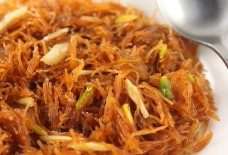As the notable American photographer Aaron Siskind once said, “Photography is a way of feeling, of touching, of loving.” And indeed it is, especially in the war-torn, blockaded, misunderstood Gaza Strip. Outside of Gaza, impressions of the Strip are limited to images of ruined buildings, poverty-stricken villages and depressed, traumatized people. And those are indeed prevalent. But Gaza also has another side—one that is joyful, thoughtful and wildly creative—that too many don’t see.
Ibrahim Faraj, a 27-year-old freelance photographer from Gaza City, has made it his mission to challenge the stereotypical images.
His talent in photography started to emerge when he was young, experimenting first with his mobile phone and only later “graduating” to a digital and then a professional camera. After earning a bachelor’s degree in journalism in 2009, just after the ceasefire that ended Israel’s brutal “Operation Cast Lead,” Ibrahim began to regularly practice his photography. However, his focus was different from everyone else’s: He looked for hope and renewed life amidst all the ravages of war.
“Gaza deserves to live, and Gazans have the right to live peacefully despite the siege and occupation,” he says.
The Sea Mermaid-Gaza version
Ibrahim’s photography often focuses on the landscape, since he sees nature as a source of hope and healing. One day, he was at the beach in Deir Al Balah, in central Gaza, and captured a shot of an 11-year-old, black-haired girl as she played in the sea. She was immersing herself in the sea, then rising up and throwing her hair back. Seeing Ibrahim with his camera, she deliberately repeated her playful action, provoking him to photograph her.
He posted the photos on his personal Facebook account, and was surprised to find it so well-received by people and other photographers around the world. However, others within Gaza found it “shameful”; the girl looked older than her age and thus the photo was considered inappropriate in the conservative Strip.
The next Friday, Ibrahim returned to the beach to prove her age to his critics. He took a picture of the two of them that time, and gave it to her as a memento. Ibrahim says with a frown, “Most of the critics of my photos ignore my main message: the beauty that is Gaza.”
His Sea Mermaid photo illustrates a power of photography that Ibrahim has mastered: “not changing reality at all, but capturing it in a way that conveys a message—in this case, that Gaza is really worthy of life.”
Despite the controversy, however, this photo showed him his way as an artist.
The Cowboy and the Violin
“The Cowboy and The Violin” is another one of Ibrahim’s most popular photos. The boy shown was raised in Beit Lahia, in the northern tip of the Gaza Strip, where his family keeps a herd of sheep. His parents also are artists: they are skilled in the Dihyya, a Bedouin Palestinian festive dance that is usually performed collectively in wedding parties. The photograph combines both aspects of Bedouin Gazan life.
Ibrahim’s favorite place, and where most of his photos are taken, is the Johr Al Deek neighborhood close to the Israeli border in the center of Gaza City. Johr Al Deek was heavily bombed during the recurrent Israeli invasions.
Among the photos he took in the neighborhood are two of Palestine’s youngest horsewoman, Hala Al Batrawi, 7 years old. Both photos show her deep affection for her white horse. Despite the recurrent and violent assaults, pure innocence is found in the relationship between girl and horse.
An Incomplete Scene
In Gaza, the horror of war memories can kill hope. Ibrahim designed this photo to communicate that there is always another door, another opportunity, even when it’s least expected.
“There will be always a ray of hope to help us survive life here,” he insists.
Children and The Cow
Children usually love animals. Innocence loves innocence. Thus, the photo series of children with cows. And then their family asked Ibrahim for copies of the photos he took, and that inspired a new series – his “subjects” with their photos.
From Passion to a Profession
Like most artists in Gaza, he suffers from a lack of proper equipment for his art. “The best photographic equipment is hard to find here, and when it is available, it is exceedingly expensive” he says.
However, that is not stopping him. Ibrahim submitted a proposal for a photography and film studio to Mobaderoon, (“entrepreneurs” in Arabic), a start-up incubator administered by the Palestinian Welfare Association with funding from the Kuwait-based Arab Fund for Economic and Social Development. His project has been accepted and will hopefully be the next phase of Ibrahim’s budding career.
His work already has been recognized with many honors, including first place in the “Gaza in Your Eyes” contest sponsored by the Welfare Association for Youth. Ibrahim also received second place in a contest organized by the Arab Photographers Group. Another dream is to publish these award-winning photos and others in “coffee-table book.”
But, due to the closed borders, he has never yet been able to travel with his work outside of Gaza. Hopefully, that dream too will eventually be fulfilled.



